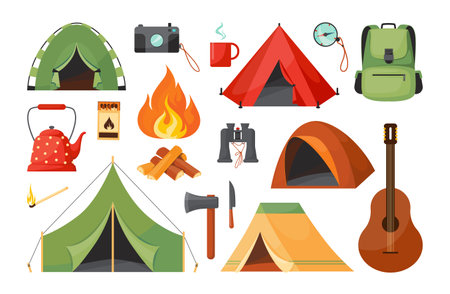1. Choosing the Right Spot: Location and Pitch
When it comes to keeping your tent dry in the unpredictable British outdoors, choosing the right pitch is absolutely crucial. Britain’s weather is infamous for its rainfall and sudden changes, so even seasoned campers can be caught off guard by soggy ground or pooling water. First off, always assess the lay of the land before you even think about unpacking your kit. Avoid low-lying areas where water naturally collects—these spots become waterlogged at the drop of a hat during heavy rain. Instead, look for gently sloping ground that encourages water runoff, but steer clear of steep inclines that could make sleeping uncomfortable or cause you to slide overnight.
Pay close attention to the local terrain: grassy areas might seem soft and inviting, but they can mask saturated soil beneath. Hard-packed earth offers better drainage but may require sturdier tent pegs. Stay well away from riverbanks and lakesides—tempting as these spots may be for their views, water levels can rise rapidly after rainfall. If camping in woodland, position your tent under the shelter of trees only if storms aren’t on the forecast; overhanging branches can drip long after rain stops, and windfall branches are a real risk.
Wind direction is another key consideration. In Britain, prevailing winds often come from the south-west, so orient your tent with its back facing into the wind for maximum stability and minimal draughts. However, avoid exposed hilltops where winds can be relentless and tents are hard to secure. By taking time to choose your location wisely and considering both rainfall patterns and natural features, you’ll greatly reduce your chances of waking up in a puddle or battling leaks during your adventure.
2. Setting Up for Success: Proper Tent Erection
When it comes to keeping dry in the unpredictable British weather, how you pitch your tent is crucial. A saggy tent invites water ingress and condensation, while a taut, well-set structure stands strong against the elements. Here’s a step-by-step guide to ensure your shelter offers top-notch moisture defence on every outing.
Step 1: Site Selection
First, scout for a spot with good drainage—avoid hollows or dips where rainwater pools. Aim for slightly elevated ground, away from overhanging trees that drip long after the rain stops.
Step 2: Laying the Groundsheet
Unfold your groundsheet (or footprint) and position it flat. It should tuck neatly under the tent base—never let it extend beyond the flysheet, as this funnels rain underneath. Check the table below for quick reference:
| Groundsheet Position | Protection Level |
|---|---|
| Tucked Under Flysheet | Maximum – prevents pooling and seepage |
| Extending Beyond Flysheet | Minimal – channels water inside tent |
Step 3: Pitching the Tent Taut
Assemble your poles and insert them fully before raising the tent. Peg out all corners tightly, starting with diagonally opposite points. Pull each corner until the fabric is drum-skin tight—this ensures rain runs off efficiently and reduces flapping in gusty conditions.
Peg Choice Matters
The right pegs make all the difference on British soil. Use sturdy steel pegs for rocky terrain and longer plastic or Y-shaped pegs for softer ground. Insert at a 45-degree angle, facing away from the tent, to maximise grip.
| Peg Type | Best For |
|---|---|
| Steel Pegs | Hard/rocky ground |
| Plastic/Y-shaped Pegs | Muddy or soft earth |
| Screw-in Pegs | Wind-exposed pitches |
Tensioning Guy Lines
Once pegged, adjust guy lines so they’re taut but not strained. This keeps the flysheet off the inner tent, creating an air gap that fends off both leaks and condensation drips—vital in our damp climate.
Follow these steps meticulously and you’ll have a bombproof shelter ready to shrug off whatever the British weather throws your way.

3. Combatting Condensation: Practical Ventilation Tips
Condensation is a persistent foe for British campers, thanks to our famously damp climate. Even the sturdiest waterproof tent can become clammy and uncomfortable if moisture from your breath and body heat has nowhere to escape. The key weapon in your arsenal? Proper ventilation. First, make strategic use of your tent’s vents. Most modern tents come equipped with mesh panels or dedicated vent flaps—keep these open whenever possible, even during light rain. Position the vents to face away from prevailing winds to avoid letting water in while still encouraging airflow. Next, don’t underestimate the power of your doors. If conditions allow, leave them partially unzipped at the top or bottom to create a cross-breeze. This not only helps expel humid air but also prevents that stifling feeling that comes with sealed-up shelters. The flysheet is another crucial component. Always pitch it taut, ensuring there’s a gap between the flysheet and the inner tent; this airspace acts as insulation and allows moist air to escape before it condenses on cold surfaces. In the often unpredictable British weather, you may be tempted to batten down every hatch—but striking a balance is vital. Remember: a slightly cooler tent with good airflow will always be drier than a stuffy one, no matter how grim it looks outside. So, embrace these techniques and keep condensation under control, even when camping in Britain’s most challenging conditions.
4. Dealing with the Wet: Tackling Leaks and Rain
Camping in the UK means you’re almost guaranteed to face a downpour or two, so being prepared to tackle leaks is essential for staying dry. The unpredictable British weather demands more than just a basic waterproof tent – you’ll need to get hands-on with maintenance and repair. Start by regularly checking your tent’s seams, as these are often the first spots where water sneaks in. Applying a quality seam sealer along both inner and outer seams can dramatically improve water resistance. Don’t wait until you’re caught in a storm; make seam sealing part of your routine before each major trip.
Essential Repairs: Minor Rips and Tears
Even the toughest tents aren’t immune to sharp rocks or bramble snags common on British campsites. A small rip can quickly become a major leak if left unattended, especially under relentless rain. Carry a repair kit that includes adhesive patches, spare fabric, and strong tape. When you spot damage, dry the area thoroughly before applying any patch or tape—damp surfaces won’t hold repairs. For best results, reinforce repairs from both inside and outside the fabric. Here’s a quick guide:
| Problem | Quick Fix |
|---|---|
| Small Rip (<5cm) | Adhesive Patch + Seam Sealer |
| Larger Tear (>5cm) | Sew shut then reinforce with patch/tape on both sides |
| Pinhole Leak | Dab with seam sealer or flexible waterproof glue |
Waterproof Sprays: An Extra Layer of Defence
The UK’s persistent showers mean factory-applied waterproofing will eventually wear thin. Regularly treat your tent’s flysheet and groundsheet with a reputable waterproof spray designed for outdoor fabrics. Do this outside on a dry day, ensuring even coverage and paying extra attention to high-wear areas like the tent floor and roof. Allow plenty of time for it to cure before packing away.
Key Tips for Waterproofing in the UK Climate
- Always test sprays on a small area first to check compatibility.
- Reapply treatments every season, or after heavy use.
- If possible, pitch your tent under natural cover (trees or hedges) for added rain protection, but avoid low-lying spots where water collects.
Treating leaks and preparing for wet weather isn’t just about comfort—it’s about survival when camping across Britain’s wild landscapes. With regular maintenance, prompt repairs, and proper waterproofing, you’ll be ready for whatever the skies throw at you.
5. Staying Organised: Gear Placement and Damp-proofing Inside
If you want to avoid that all-too-common British camping disaster – waking up to find your kit soaked through – a methodical approach to organisation inside your tent is absolutely essential. Keeping things dry in our famously unpredictable weather isn’t just about pitching technique; it’s about what you do once you’re inside. Here’s how to keep your gear sorted, your sleeping bag bone-dry, and the mood chipper even when it’s lashing down outside.
Best Practices for Keeping Kit Dry
Start by separating wet gear from dry as soon as you step inside. Designate a specific area (ideally near the entrance) for boots, waterproofs, and anything else that might be harbouring moisture. Use dry bags or heavy-duty bin liners for any kit that must stay completely dry – especially electronics, spare clothing, and bedding. Never place damp items on top of or next to your sleeping space; moisture will migrate quickly, particularly in confined tents with limited airflow.
Using Storage Solutions
Invest in mesh organisers or hanging pockets that attach to your tent’s interior. These are brilliant for keeping essentials off the groundsheet and away from condensation-prone corners. If your tent has a porch, use it wisely: store rucksacks and larger items here rather than inside the sleeping compartment. For added protection, lay down a small tarp or groundsheet beneath stored kit to prevent contact with seepage or standing water.
Maintaining a Tidy Sleeping Area
A clutter-free tent isn’t just more comfortable; it’s far easier to keep dry. Keep your sleeping bag rolled up and stowed away in its sack until you’re ready for bed, and always have a dedicated spot for each item so nothing gets misplaced or left out in the damp overnight air. Shake out damp clothes before bringing them in and hang them on a makeshift line in the porch if possible – never drape them over your bedding. Finally, do a quick check before zipping up for the night: no wet socks lurking by your pillow, no muddy kit encroaching on your mat. With a disciplined approach, you’ll wake up drier and warmer, ready to face whatever the British skies throw at you.
6. Quick Reactions: What to Do When Things Get Wet
Even the best-prepared British camper can get caught out by a sudden downpour, relentless drizzle, or a sneaky drip in the early hours. When your kit or sleeping bag gets wet, it’s time for swift, no-nonsense action—this isn’t the moment for dithering. Here’s how to take charge and salvage your gear with proper British resourcefulness.
Assess and Isolate the Wet Gear
The first step is to spot what’s wet and act fast. If your sleeping bag or clothes have taken on water, pull them out of the puddle immediately. Keep sodden items away from dry kit to prevent further spreading of dampness. Use dry bags or bin liners—never underestimate the value of a sturdy black sack in British camping circles—to separate wet from dry.
Get Airflow Going
If you’ve got a break in the weather, open up vents, doors, and flysheet flaps wide. Get as much fresh air circulating as possible. Even on a blustery British hillside, wind can be your best friend for drying things out. Hang soggy items over guy lines, trees, or even drape them over camp chairs if you have them. Don’t be shy about using every available surface.
Blot and Wring Out Excess Water
Use microfibre towels, spare T-shirts, or whatever absorbent cloth you have to blot moisture from kit and tent fabric. Wring out clothing thoroughly—don’t just hang up dripping garments and hope for the best.
Prioritise Essential Kit
Focus on getting your sleeping bag, base layers, and socks dry first—these are non-negotiables for warmth overnight in a British climate. Less critical items can wait until later or be left in the porch if necessary.
Patch Up Leaks on the Spot
If you find a leaking seam or hole in your tent mid-deluge, slap on some duct tape (gaffer tape is king at any UK festival or campsite). For serious leaks, fashion an emergency patch from a plastic bag and secure with tape until you can fix it properly back home.
Stay Warm While You Dry Out
Wet kit means cold campers—a recipe for misery under British skies. Layer up with anything dry you’ve got left; use foil blankets or hot water bottles if needed. Hot brews from your camping stove will lift morale and body temperature while you sort things out.
Keep Calm and Carry On
The most important lesson drawn from generations of British camping: don’t panic. Weather turns quickly here; resilience is part of the adventure. Salvage what you can, adapt your plans if needed, and remember—a sense of humour goes further than any piece of fancy kit when faced with classic British rain.


